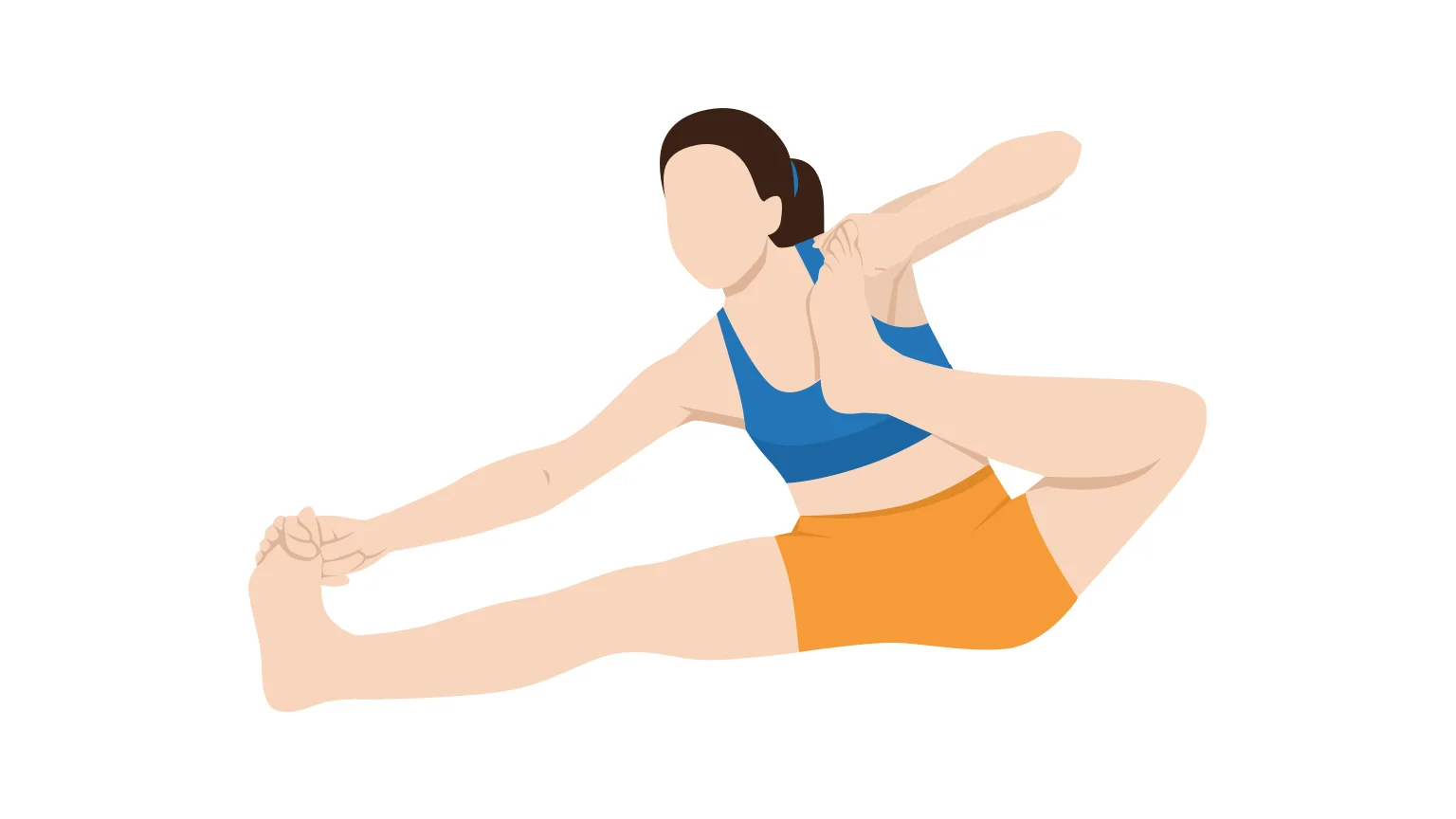Archer’s Pose (Shooting Bow Pose, Akarna Dhanurasana)

The Archer’s Pose, also known as The Shooting Bow Pose or Akarna Dhanurasana, is a seated yoga pose. In this pose, you adopt a seated position, with your legs first extended out. You then reach out and hold one foot, bring it up towards your chest, while holding onto your extended foot with your other hand. This pose imitates the action of an archer pulling back the arrow on their bow.
- Position: Seated.
- Stretched body parts: The Archer’s Pose stretches your hamstrings, thighs, shoulders and your abdominal muscles.
- Benefits: The Archer’s Pose stretches the back muscles, making the spine more flexible. It can also aid in digestion because of the stretching across your abdominal muscles.
- Symbolism: Archery was a primary method of fighting during the Mahabharata epic. The Mahabharata epic is one of the two major Sanskrit epics of ancient India. It is a narrative of the Kurukshetra War and the fates of the Kaurava and the Pandava princes. The Archer’s Pose is a nod to the form and qualities of an archer – precision, focus and patience.
- Similar poses: Bow Pose (Dhanurasana), Camel Pose (Ustrasana), Cobra Pose (Bhujangasana)
Meaning of Akarna Dhanurasana
The name “Akarna Dhanurasana” comes from three Sanskrit words:
- “Akarna” means “up towards the ears”;
- “Dhanur” means “bow”; and
- “Asana” means “pose”.
Put together, we get the name “Akarna Dhanurasana” which translates literally to “Bow [pulled] up towards the ears pose”, more commonly known as the Archer’s Pose.
In the ancient epic (poem) Mahabharata, archery emerged as a key weapon of warfare. This poem describes the saga of the Kurukshetra War, a conflict between the Kaurava and Pandava dynasties.
The Archer’s Pose is a yoga asana that mirrors the strength and unwavering concentration of a warrior drawing his bow. The pose serves as a bridge that connects the wisdom of the ancients with the seekers of the present.
Practicing The Archer’s Pose is believed to bring a balance between the body, breath, and mind, leading to improved concentration and calmness.
How to do The Archer’s Pose
- First, sit in the Dandasana (Staff Pose). Sit upright with your spine straight and your legs extended out in front of you.
- Bend your left knee and, holding onto your big toe with your left hand, bring the foot up and close to your body.
- Now, with your right hand, reach out to your right foot and hold onto your big toe.
- Rotate your right leg out to the side as far as is comfortable.
- Now, bending your elbow, draw your left arm back, pulling your foot. Imagine this action as the drawing of an arrow on your bow.
- Gaze in the direction of your right leg, looking straight forwards, as if you were aiming the bow.
- Hold for a few breaths, and consciously stretch your legs and arms.
- Gently release your left leg and return back to the Dandasana pose.
- Now repeat the pose on the other side.
Variations
- For extra support: Use a yoga strap around the foot of your extended leg if you have difficult reaching forward to hold your big toe.
- Easier pose: You can also maintain a slightly bend in the knee of your extended leg if you have difficulty reaching forwards. You might also position a rolled towel beneath your knee for extra support.
- More challenging: Try raising your extended leg up into the air. This will stretch your hamstrings and glutes and require more balance and control.
Tips
- This pose requires a lot of flexibility, so make sure you do some warm up prep poses first.
- Keep your back straight during the pose to avoid unnecessary strain.
- If you find it difficult to extend your leg fully, don’t force yourself into this position. Start with a bended knee. With more practice, you will build up flexibility over time.
- Always perform The Archer’s Pose on both sides of your body to build equal balance and strength.
Prep poses
- Seated Forward Bend (Paschimottanasana) – The Seated Forward Bend stretches the muscles of your back, hamstrings and hips, which increases your flexibility before performing The Archer’s Pose.
- Head-to-Knee Pose (Janu Sirsasana) – Stretches your hamstrings, groin and shoulders, all muscles used in The Archer’s Pose.
- Wide-Angle Seated Forward Bend (Upavistha Konasana) – This pose helps stretch your hamstrings and inner thigh muscles. The increased flexibility will help when performing more advanced poses.
- Bound Angle Pose (Baddha Konasana) – The Bound Angle Pose is a great hip opener pose. This increases the flexibility and range of motion in your hips, which is important when you rotate out your leg in poses like The Archer’s Pose.
